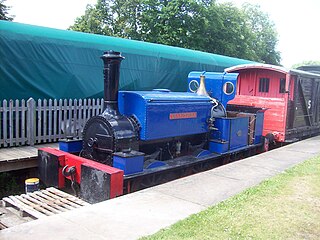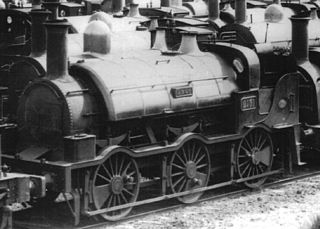
Under the Whyte notation for the classification of steam locomotives, 4-6-2 represents the wheel arrangement of four leading wheels on two axles, six powered and coupled driving wheels on three axles and two trailing wheels on one axle. The 4-6-2 locomotive became almost globally known as a Pacific type after a locomotive built by the Baldwin Locomotive Works in Philadelphia was shipped across the Pacific Ocean to New Zealand.

4-4-0, in the Whyte notation, denotes a steam locomotive with a wheel arrangement of four leading wheels on two axles, four powered and coupled driving wheels on two axles, and no trailing wheels.

A Crampton locomotive is a type of steam locomotive designed by Thomas Russell Crampton and built by various firms from 1846. The main British builders were Tulk and Ley and Robert Stephenson and Company.

The Great Western Railway 3252 or Duke Class were 4-4-0 steam locomotives with outside frames and parallel domed boilers. They were built in five batches between 1895 and 1899 for express passenger train work in Devon and Cornwall. William Dean was their designer, possibly with the collaboration of his assistant, George Jackson Churchward. Four prototype 4-4-0s, of the Armstrong Class, had already been built in 1894.

The Great Western Railway (GWR) Star Class of 2-2-2 broad gauge steam locomotives were used for passenger train work. Designed by Robert Stephenson, the class was introduced into service between November 1838 and November 1841, and withdrawn between April 1864 and September 1871.

The Great Western Railway Premier Class 0-6-0 broad gauge steam locomotives for goods train work. This class was introduced into service between February 1846 and May 1847, and withdrawn between March 1866 and June 1872.

The Great Western Railway Sun Class were 2-2-2 broad gauge steam locomotives for passenger train work. This class was introduced into service between April 1840 and January 1842, and withdrawn between January 1864 and June 1879.
The Highland Railway began as the Inverness and Nairn Railway, which operated the other lines which became part of the Highland Railway on its formation in 1865. For post-1870 locomotives, see Locomotives of the Highland Railway.

Manning Wardle was a steam locomotive manufacturer based in Hunslet, Leeds, West Yorkshire, England.

The Duffield Bank Railway was built by Sir Arthur Percival Heywood in the grounds of his house on a hillside overlooking Duffield, Derbyshire in 1874. Although the Ordnance Survey map circa 1880 does not show the railway itself, it does show two tunnels and two signal posts. However, the online map archive of the National Library of Scotland includes a map of 1914 from the 25 inches to the foot series that shows the full extent of the railway.
Haigh Foundry was an ironworks and foundry in Haigh, Lancashire, which was notable for the manufacture of early steam locomotives.
Little information remains about the North Midland Railway Locomotives. Unlike other railway companies, the North Midland Railway of England did not give names to its locomotives.

The Dean Single, 3031 Class, or Achilles Class was a type of steam locomotive built by the British Great Western Railway between 1891 and 1899. They were designed by William Dean for passenger work. The first 30 members of the class were built as 2-2-2s of the 3001 Class.

The eight Dido class locomotives were 0-6-0ST broad gauge locomotives operated on the South Devon Railway and Cornwall Railway and associated other adjacent railways. They were designed for goods trains but were also used on passenger trains when required.
The first 19 locomotives ordered by Isambard Kingdom Brunel for the Great Western Railway included six 2-2-2 Charles Tayleur locomotives. They were built by Charles Tayleur and Company, which became later the Vulcan Foundry. The locomotives were unsuccessful and rapidly supplemented by the Star Class locomotives ordered by Daniel Gooch once he had been appointed as the Locomotive Engineer. As built, they comprised two groups of three: the first group, delivered in 1837, had cylinders having a bore of 14 inches (360 mm) and the second group, delivered in 1838, had cylinders having a bore of 12 inches (300 mm); all had a stroke of 16 inches (410 mm).

The first 19 locomotives ordered by Isambard Kingdom Brunel for the Great Western Railway included two unusual Haigh Foundry locomotives.

The South African Railways Class 16E 4-6-2 of 1935 is a class of passenger steam locomotive.

The South African Railways Class 15CA 4-8-2 of 1926 was a steam locomotive.

The LNWR 4ft 6in Tank was a class of 220 passenger 2-4-2T locomotives manufactured by the London and North Western Railway in their Crewe Works between 1879 and 1898. The "4ft 6in" in the title referred to the diameter of the driving wheels – although the stated dimension was for the wheel centres – the nominal diameter including the tyres was 4 ft 8+1⁄2 in (1,435 mm).

The LNWR Teutonic class was a class of 10 passenger three-cylinder compound 2-2-2-0 locomotives designed by F. W. Webb for the London and North Western Railway, and manufactured by them in their Crewe Works between 1889 and 1890.
















